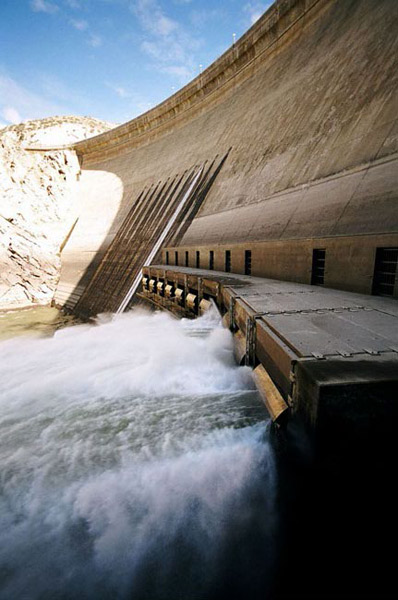- Reclamation
- Columbia-Pacific Northwest Region
- About Us
- Dams and Projects
Dams & Projects
Projects | Photo Gallery | Safety of Dams Program | Annual Dam Operator Training
Types of Dams

All dams can be classified as one of two types: either "massive" or "structural." The massive tradition includes all gravity dams,in which stability is provided solely by the weight of the material used. Variations in gravity dam design such as a straight, curved, or crooked crest, do not alter this basic design principle. Massive dams are further categorized by material—concrete, masonry, earthen, or rock fill—because each material type requires different construction methods.
In other dams, stability is provided not by gravity but by application of scientific principles and innovative engineering. Usually, structural dams are designed in response to challenges such as limited funds, manpower, or material. The two primary structural dam types are arch dams and buttress dams. Variations within these two types are related to design evolutions in shape, height, and geometric properties. In this context, "large scale" usually means height or length, not the amount of material used in construction. The engineering significance of a structural dam may be because of the inverse proportion of mass to height and length. For example, Arrowrock Dam and Hungry Horse Dam are both relatively thin at their base in proportion to their height.
Function of Dams
A dam is either "run of river" or intended to store water. Reclamation's run of river projects, such as Boise Diversion Dam and Black Canyon Dam have limited storage and were developed primarily for power generation. At run-of-river projects, outflow is virtually the same as inflow. Reservoir levels at run-of-river projects vary only a few feet in normal operations, but that is enough to provide water for power generation or navigation.
But not all power-producing dams are run-of-river projects. Storage dams, such as Grand Coulee and Hungry Horse, have a large reservoir capacity and are multi-purpose projects. The reservoirs capture spring runoff and are the first line of defense against flooding. Because water from rain and snowmelt in the spring and summer may be more than is required at the time for irrigation or power production, reservoirs store the spring runoff until the late summer or fall. Water releases later in the year provide flows and water levels needed for fish migration, irrigation, recreation, navigation, and power generation. Full reservoirs also provide significant recreation benefits and sustain fish and wildlife.

